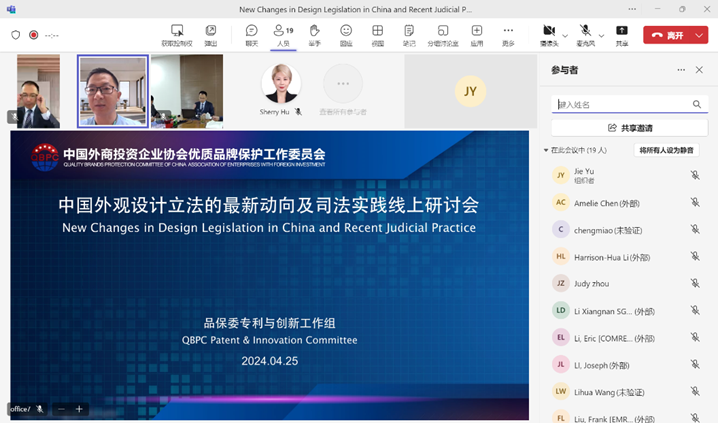On April 25, the Quality Brands Protection Committee of the China Association of Enterprises with Foreign Investment (QBPC) Patent and Innovation Committee hosted an online seminar on New Changes in Design Legislation in China and Recent Judicial Practice. CHENG Miao discussed the latest trends in design legislation, changes in application practice, features and typical cases of design rights protection, as well as co-opetition and conflicts between design and other intellectual property rights (IPR). The event was moderated by PIC Vice Chair Simon Xia, and over 20 QBPC members participated online.

First, CHENG highlighted the latest developments in China's design protection practice and legislation. China has strengthened the design protection through legislation such as the Patent Law, implementation regulations and examination guidelines, showing a flexible attitude towards design issues. He also gave an in-depth analysis of the impact of the changes in laws and regulations on businesses and how businesses could utilize these provisions to establish their design patent protection strategies.
Secondly, he analyzed the changes in the practical changes of design application from the perspectives of global layout strategy and Chinese application strategy. He talked on the Hague Convention’s review mechanism and the impact of China's accession on the global layout strategy of businesses. Regarding the application strategy in China, he underlined that the introduction of the national priority system had provided businesses with more flexibility. Furthurmore, he discussed partial design protection and graphical user interface, as well as the relevant factors that businesses should consider when applying for them.
With eight typical case studies, CHENG explained the views of courts and key points of judicial decisions in design patent cases.
Regarding the co-opetition and conflict between design and other IPRs, CHENG emphasized on the importance of leveraging IPRs and other rights to protect the innovation, and introduced some overseas views on rights co-opetition as well as some latest judicial cases in China. Through analyzing actual cases, he also explained how right holders could create comprehensive right protection strategies in case of co-opetition and conflicts between design patents and trademarks, copyrights and product packaging and decoration rights.
In the Q&A Session, the speakers answered the questions raised by the participants, such as the probability of partial invalidation of the design and the factors affecting it, the exceptions to repeated authorization under the domestic priority, whether the plaintiffs could defend their rights after the expiration of design patent right, and so on.
